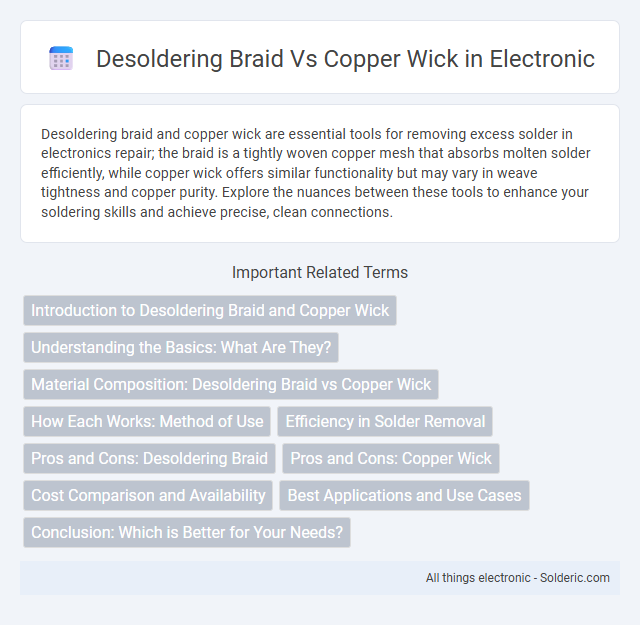Desoldering braid and copper wick are essential tools for removing excess solder in electronics repair; the braid is a tightly woven copper mesh that absorbs molten solder efficiently, while copper wick offers similar functionality but may vary in weave tightness and copper purity. Explore the nuances between these tools to enhance your soldering skills and achieve precise, clean connections.
Comparison Table
| Feature | Desoldering Braid | Copper Wick |
|---|---|---|
| Material | Fine braided copper wire | Fine braided copper wire (same as desoldering braid) |
| Purpose | Remove solder from PCB pads and joints | Remove solder from PCB pads and joints |
| Flux Coating | Typically coated with rosin flux for effective solder absorption | Same; often coated with rosin flux |
| Usage | Place on solder joint, heat with soldering iron, solder is absorbed by braid | Same method as desoldering braid |
| Heat Resistance | High, designed to withstand soldering temperatures | High, comparable to desoldering braid |
| Effectiveness | Efficient for removing solder; depends on quality and flux coating | Equivalent effectiveness as desoldering braid |
| Reusability | Usually single-use or limited reuse due to solder contamination | Same usage limitation as desoldering braid |
| Cost | Generally low-cost and widely available | Often the same cost and availability |
Introduction to Desoldering Braid and Copper Wick
Desoldering braid and copper wick are essential tools for removing excess solder from electronic components during repair or assembly. Desoldering braid, composed of fine copper strands woven into a flat tape, efficiently absorbs molten solder when heated, ensuring clean removal without damaging the circuit board. Your choice between these tools depends on the specific soldering task, as both provide precise control for maintaining the integrity of delicate electronic parts.
Understanding the Basics: What Are They?
Desoldering braid and copper wick refer to the same tool used in electronics for removing solder from circuit boards. Made of fine woven copper strands, this braid absorbs molten solder through capillary action, facilitating clean and precise desoldering. The primary difference lies in terminology, with "copper wick" emphasizing the material composition and "desoldering braid" highlighting its functional use.
Material Composition: Desoldering Braid vs Copper Wick
Desoldering braid and copper wick both consist primarily of fine woven copper strands designed to absorb molten solder through capillary action. Desoldering braid typically features a flux coating that enhances solder removal efficiency by promoting better heat transfer and preventing oxidation during the desoldering process. Copper wick, often considered synonymous with desoldering braid, may come without flux, requiring external flux application to improve its solder absorption capabilities.
How Each Works: Method of Use
Desoldering braid and copper wick operate by capillary action to remove molten solder from electronic joints. The desoldering braid is placed directly onto the soldered area, and a heated soldering iron presses the braid, causing the solder to melt and be drawn into the fine copper strands. Both methods require careful control of iron temperature and pressure to avoid damaging components while effectively lifting solder away.
Efficiency in Solder Removal
Desoldering braid and copper wick both serve to remove solder from electronic components, but copper wick typically offers superior efficiency due to its tightly woven copper strands that quickly absorb molten solder. High-quality desoldering braid with flux embedded enhances solder removal speed and cleanliness by promoting better heat transfer and fluidity. The effectiveness depends on factors such as braid width, flux type, and solder composition, making copper wick an essential tool for precise and rapid desoldering tasks.
Pros and Cons: Desoldering Braid
Desoldering braid, also known as copper wick, efficiently removes excess solder from circuit boards, making repairs and rework cleaner and more precise. Its pros include excellent heat conductivity, ease of use, and availability in various widths and copper thicknesses, enabling versatility for different soldering tasks. However, cons involve the need for proper technique to avoid pad damage, limited reuse, and potential residue contamination if not cleaned thoroughly after use.
Pros and Cons: Copper Wick
Copper wick offers excellent thermal conductivity, allowing efficient heat transfer to quickly remove solder from electronic components. Its flexibility and thin strands enable precise control in tight spaces but can sometimes fray, reducing effectiveness and causing difficulty in reuse. Although copper wick is cost-effective and widely available, it may oxidize over time, requiring proper storage to maintain durability and performance.
Cost Comparison and Availability
Desoldering braid and copper wick both serve the same purpose of removing solder, but copper wick tends to be more cost-effective and widely available in electronics stores and online marketplaces. Your choice may lean towards copper wick due to its affordability and abundance compared to branded desoldering braids, which can sometimes be pricier and less accessible. Evaluating the cost per meter and availability in local supply chains will help you make an efficient purchase decision.
Best Applications and Use Cases
Desoldering braid and copper wick both serve to remove excess solder, but the braid is typically preferred for precision work on delicate components due to its thin, flexible design that absorbs solder efficiently. Copper wick is better suited for larger joints or heavy solder removal because its thicker strands can handle higher heat and more extensive solder amounts without breaking down. In electronics repair, desoldering braid excels in surface-mount device (SMD) applications, while copper wick is ideal for through-hole components and extensive repair tasks.
Conclusion: Which is Better for Your Needs?
Desoldering braid and copper wick both serve to remove solder effectively, but copper wick generally offers superior heat conduction for faster solder absorption. Desoldering braid is ideal for precise, small-scale tasks due to its thin and flexible strands, while copper wick suits heavier, industrial applications requiring robust solder removal. Choosing between them depends on the complexity of the project and the type of solder used, with copper wick preferred for efficiency and desoldering braid favored for detailed electronic work.
Desoldering braid vs copper wick Infographic

 solderic.com
solderic.com